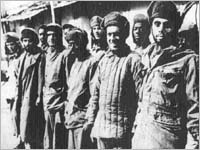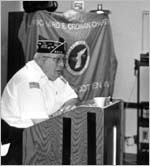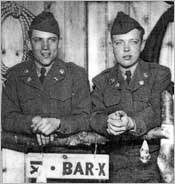 |
 |
 |
||||
 |
Home | Cold War Turns Hot | The Armed Forces Integrate | What the Experts Say | ||||
|
The Cold War Turns Hot
Closure
Vince met Lovejoy a few months later at a POW reunion in Georgia. They hugged and sat down in Vince's hotel room. Lovejoy brought a picture of Richard that he'd kept since 1950. He'd also written the Krepps family's old Pennsylvania address, told to him by Richard, in a small notebook. In Camp Five that winter, Lovejoy told Vince, Richard was ill and depressed - so sad and homesick that he seemed to give up. Lovejoy couldn't get Richard to eat his meager rations of millet and barley. "And one morning I guess he went to talk to Richard and he didn't respond, and Richard had died," Vince says, recalling Lovejoy's story. "And the guards took [Richard] out and they stacked him on top of a bunch of other dead prisoners like cord wood. And they just laid there 'til somebody came along and buried them. "I guess Ron put closure on the fact that somebody cared about Richard," Vince says, making no effort to fight back tears. "Somebody tried to feed him, somebody tried to make him well enough to come home. And that's all I ever asked for. I wanted to make sure he had a friend." Vince says the war will really be finished for him if and when Richard's remains come home. Richard is one of more than 8,000 Korean War POW's and MIA's still unaccounted for. Of the 1.8 million Americans who served in the Korean War, perhaps half are still alive. A couple dozen of them met for breakfast one Sunday morning in March, 2003, at a firehouse in Delray Beach, Florida.
Havaline speaks so breezily about the prospect of death, perhaps, because he came so close to it a half-century ago. Havaline's face - and, he says, the skin on 80% of his body - is disfigured from a "friendly" napalm attack on Heartbreak Ridge, on Christmas Eve, 1952. A 2nd Division officer called in an air strike, but in the dark the Air Force plane dropped its load on U.S. troops. "There were 285 of us. I'm the only one that came out of it alive. My 284 buddies were all burned to death," Havaline says. Havaline betrays no bitterness toward the Air Force pilot or the government that sent him to Korea. "I served when I had to serve and I got hurt, unfortunately. But I'm not sorry. I would have done it again if I had to." Many Korean War vets, as boys, had watched young men just a few years older than themselves go off to World War II and return as celebrated heroes. Most went to Korea with a similar sense of unquestioning duty. But coming home in uniform in 1953 was not like it had been in 1945. Ask Korea veterans about their coming-home experience, and you get a similar story again and again. Army veteran Peter Taormina, now of Boynton Beach, went back to his old neighborhood on Manhattan's Upper East Side in 1953. "I went to this park that we used to hang out and play ball in," Taormina remembers. "There was a couple of guys playing handball there that I knew. I hadn't seen these guys in about three years. 'Hey, Pete, where you been? I haven't seen you around in awhile!' I mean you just came back to nothing." "I'm a little bitter," says Army veteran Al Ratner when asked about what's often called the forgotten war. "People don't give you regard for Korea." Ratner, who's originally from Brooklyn, sometimes gives talks about the war to south Florida schoolchildren. He tells them a peace treaty was never signed, and the U.S. military never left. The two sides never stopped pointing weapons at one another across the border. "From 1953 to present, there was 218 Americans got killed." Ratner tells the students that 37,000 U.S. troops still defend South Korea. "Know what the kids tell us?" Ratner says, a wry glint in his eye. "'Are they as old as you?'" In 1999, President Clinton declared Korea not a police action but a war.
Vince Krepps says he never tires of telling his story - and, especially, that of his twin brother, Richard, one of the 36,891 Americans who died in the Korean War. "I'm just proud of him and proud of what he did," says Vince. "I would have loved to had him come home and enjoy what we have now, even though some people may think these are tough times. I don't think they really know what tough means."
|
|||||


